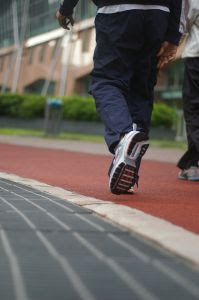 Every day my sixth-floor walk-up reminds me that I could be in better shape. I hit the gym every morning and do a few endurance events a year, but I’m always out of breath when I reach the top of the stairs.
Every day my sixth-floor walk-up reminds me that I could be in better shape. I hit the gym every morning and do a few endurance events a year, but I’m always out of breath when I reach the top of the stairs.It’s not only humbling, but it’s also annoying. How can I run a 5K at a seven-minute-mile pace and not make it to the top of the stairs without panting?
Here’s why: Unlike running, stair climbing has a vertical element. This upwards movements makes your lower body muscles—quads, hamstrings, and glutes—work harder to lift your body weight against gravity. Common activities such as running, swimming, and biking get your heart rate up, but none of them have the vertical element. Most of your daily activities move you forward instead of up, which is why our bodies aren’t used to fighting gravity.
And for a 130-pound woman, simply walking up stairs burns only 60 calories less than jogging at 6 mph for the same amount of time. Not to mention the added bonus of tightening up your lower half.
So, it’s not surprising that stair-running events have begun to sprout up worldwide in all sorts of historic settings. There’s the Go Vertical Chicago climb in Chicago, the CN Tower climb in Toronto, and my personal favorite, the Empire State Building Run-Up.
I’ve done a lot of crazy things in my life—namely, swimming in the Hudson River—but running 86 flights of stairs seems slightly insane. Or is it?
A 2000 study found that for sedentary women, even a few minutes of daily stair climbing can improve cardiovascular health by reducing heart rate, oxygen uptake, and blood lactate, and improving good cholesterol. If climbing stairs six times a day (like the women in the study did) had that effect, then maybe the key to bumping up my workouts lies in taking a few more trips up and down my stairs.
Now that I’m set to run the NYC Half Marathon at the end of March, I’m looking for anything that will help me beat my last half marathon time of 1:42. And I think the way to do that lies in finishing my runs with a race up to the top of the stairs. Because if I can beat gravity, they I can surely beat my former time.
source: health.com



